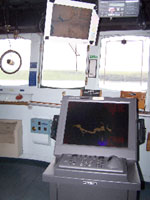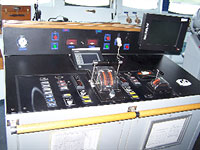

 | |||||||||||||||||
|
|
Journals 2009/2010Aundrea Rue
August 3, 2009 Today I was scheduled to do night processing in the plotting room once the launches returned from acquiring data at sea. The weather, however, was uncooperative and prevented any boats from going out. Obviously, if there is no information gathered, there is no processing of said information to be done. So I decided to get another tour of the ship. Today I learned about the bridge, which is also known as the pilot house. It is for the ship what the main office at a school is. Navigation, weather data and the actual driving of the ship are done from the bridge. The physical driving of the ship is done by a deck hand, while the conning officer, a NOAA Corps officer, is responsible for navigation and preventing collisions. The gyrometer is used to navigate directionally because it always points to true north, as opposed to magnetic north, which fluctuates on a regular basis. By turning the wheel in either direction, the numbers on the display change and more accuracy is obtained. Besides the gyrometer, radar, GPS and nautical charts are used to ensure that the ship's positioning is correct.
Various types of radio and their frequencies are used and monitored to contact other ships. For example, if a ship was sinking and needed to make a "mayday" call, it would be done on the radio frequencies that are mandated to be constantly monitored.
In addition to all of the equipment used to run the ship, someone is always on watch on the bridge, monitoring the radios and, when anchored, making sure that the ship stays in place. I had no idea that so much went into sailing a ship. Believe me, it's a lot more involved than driving a car! |
||||||||||||||||



